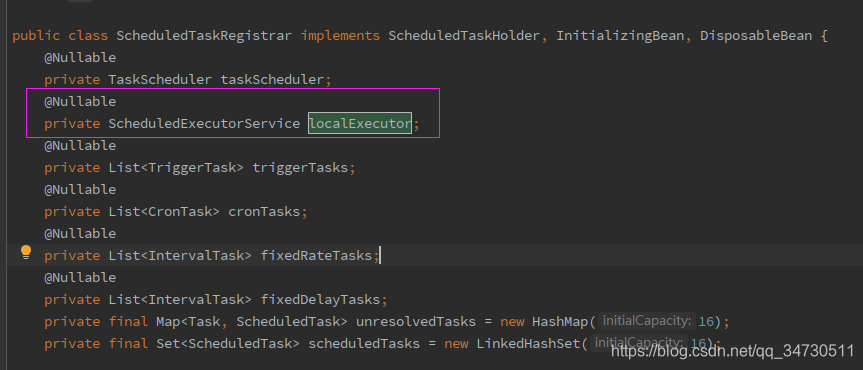最近项目中经常有用到@Scheduled注解,在内测时由于数据量小(没有进行压力测)所以每个线程执行都很快,但线上后发现部分功能无法使用,最后定位是部分的定时器没有执行,后查阅资料和Springboot源码后


ScheduledTaskRegistrar在启动时,如果没有指定线程池的大小,默认会创建核心线程数为1的默认线程池,故而当项目中出现多个@Scheduled线程时,只能一个个的执行,从而导致个别线程执行时间过长(或长期执行)时,其他定时器不能按照指定的规则进行执行。解决方法
1.在项目初始化时指定其执行线程池的大小
import org.springframework.boot.autoconfigure.batch.BatchProperties;
import org.springframework.context.annotation.Configuration;
import org.springframework.scheduling.annotation.Scheduled;
import org.springframework.scheduling.annotation.SchedulingConfigurer;
import org.springframework.scheduling.config.ScheduledTaskRegistrar;
import java.lang.reflect.Method;
import java.util.Arrays;
import java.util.Objects;
import java.util.concurrent.ScheduledThreadPoolExecutor;
import java.util.concurrent.atomic.AtomicInteger;
/**
* 程序名 : ScheduledTaskConfiguration
* 建立日期: 2021-02-23 9:33
* 模块 : Scheduled任务线程池设置
* 描述 : 读取项目中使用了@Scheduled注解的方法,默认所有方法在项目创建时都需要按照设定的规则执行
* 备注 : //TODO
* <p>
* 修改历史
* 序号 日期 修改人 修改原因
*/
@Configuration
public class ScheduledTaskConfiguration implements SchedulingConfigurer {
@Override
public void configureTasks(ScheduledTaskRegistrar taskRegistrar) {
Method[] methods = BatchProperties.Job.class.getMethods();
final AtomicInteger corePoolSize = new AtomicInteger();
if (Objects.nonNull(methods) && methods.length > 0) {
Arrays.stream(methods).forEach(method -> {
final Scheduled annotation = method.getAnnotation(Scheduled.class);
if (Objects.nonNull(annotation)) {
corePoolSize.incrementAndGet();
}
});
}
ScheduledThreadPoolExecutor executor = new ScheduledThreadPoolExecutor(corePoolSize.get());
taskRegistrar.setScheduler(executor);
}
}
2.将定时器设置为异步线程
/**
异步线程
定时器延迟1秒启动,每距上一次执行完成后间隔3秒执行一次
*/
@Async("taskExecutor")
@Scheduled(initialDelay = 1000L, fixedDelay = 3000L)
public void test(){
System.out.println("---"+System.currentTimeMillis());
//业务内容
}
版权声明:本文为qq_34730511原创文章,遵循 CC 4.0 BY-SA 版权协议,转载请附上原文出处链接和本声明。